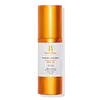What's inside
What's inside
 Key Ingredients
Key Ingredients

 Benefits
Benefits

 Concerns
Concerns

 Ingredients Side-by-side
Ingredients Side-by-side

Water
Skin ConditioningGlycerin
HumectantOleth-20
CleansingSodium Ascorbyl Phosphate
AntioxidantHydroxyethylcellulose
Emulsion StabilisingPhenoxyethanol
PreservativeCaprylyl Glycol
EmollientHexylene Glycol
EmulsifyingCitric Acid
BufferingParfum
MaskingPEG-12 Dimethicone
Skin ConditioningTocopheryl Acetate
AntioxidantAroma
Hydrolyzed Vegetable Protein
Skin ConditioningDisodium Phosphate
BufferingPolysorbate 60
EmulsifyingAloe Barbadensis Leaf Extract
EmollientCitrus Aurantium Dulcis Fruit Extract
MaskingSodium Hyaluronate
HumectantThioctic Acid
AntioxidantCalcium Ascorbate
AntioxidantSodium Phosphate
BufferingSorbitol
HumectantCitrus Grandis Seed Extract
AstringentSodium Benzoate
MaskingAscorbic Acid
AntioxidantCamellia Sinensis Leaf Extract
AntimicrobialEuphrasia Officinalis Extract
AntimicrobialRosa Canina Fruit Extract
AstringentLeuconostoc/Radish Root Ferment Filtrate
AntimicrobialPotassium Sorbate
PreservativeTriacetin
AntimicrobialSodium Benzotriazolyl Butylphenol Sulfonate
UV AbsorberBenzyl Benzoate
AntimicrobialLimonene
PerfumingLinalool
PerfumingCI 15985
Cosmetic ColorantWater, Glycerin, Oleth-20, Sodium Ascorbyl Phosphate, Hydroxyethylcellulose, Phenoxyethanol, Caprylyl Glycol, Hexylene Glycol, Citric Acid, Parfum, PEG-12 Dimethicone, Tocopheryl Acetate, Aroma, Hydrolyzed Vegetable Protein, Disodium Phosphate, Polysorbate 60, Aloe Barbadensis Leaf Extract, Citrus Aurantium Dulcis Fruit Extract, Sodium Hyaluronate, Thioctic Acid, Calcium Ascorbate, Sodium Phosphate, Sorbitol, Citrus Grandis Seed Extract, Sodium Benzoate, Ascorbic Acid, Camellia Sinensis Leaf Extract, Euphrasia Officinalis Extract, Rosa Canina Fruit Extract, Leuconostoc/Radish Root Ferment Filtrate, Potassium Sorbate, Triacetin, Sodium Benzotriazolyl Butylphenol Sulfonate, Benzyl Benzoate, Limonene, Linalool, CI 15985
Zinc Oxide 17.5%
Cosmetic ColorantDimethicone
EmollientAscorbic Acid
AntioxidantCaprylic/Capric Triglyceride
MaskingPolysilicone-11
Stearalkonium Bentonite
Gel FormingMica
Cosmetic ColorantCamellia Sinensis Leaf Extract
AntimicrobialLinoleic Acid
CleansingCholesterol
EmollientTartaric Acid
BufferingAmaranthus Caudatus Seed Oil
EmollientHordeum Vulgare Extract
EmollientTriticum Vulgare Germ Oil
EmollientSqualane
EmollientCI 77891
Cosmetic ColorantPolyhydroxystearic Acid
EmulsifyingTocopheryl Acetate
AntioxidantPolyglyceryl-3 Polyricinoleate
EmulsifyingIsostearic Acid
CleansingLecithin
EmollientPropylene Carbonate
SolventCI 77491
Cosmetic ColorantCoco-Caprylate/Caprate
EmollientPolyglyceryl-6 Polyricinoleate
EmulsifyingDisodium Stearoyl Glutamate
CleansingDilinoleic Acid/Butanediol Copolymer
Castor Oil/Ipdi Copolymer
Zinc Oxide 17.5%, Dimethicone, Ascorbic Acid, Caprylic/Capric Triglyceride, Polysilicone-11, Stearalkonium Bentonite, Mica, Camellia Sinensis Leaf Extract, Linoleic Acid, Cholesterol, Tartaric Acid, Amaranthus Caudatus Seed Oil, Hordeum Vulgare Extract, Triticum Vulgare Germ Oil, Squalane, CI 77891, Polyhydroxystearic Acid, Tocopheryl Acetate, Polyglyceryl-3 Polyricinoleate, Isostearic Acid, Lecithin, Propylene Carbonate, CI 77491, Coco-Caprylate/Caprate, Polyglyceryl-6 Polyricinoleate, Disodium Stearoyl Glutamate, Dilinoleic Acid/Butanediol Copolymer, Castor Oil/Ipdi Copolymer
Alternatives
Ingredients Explained
These ingredients are found in both products.
Ingredients higher up in an ingredient list are typically present in a larger amount.
Ascorbic Acid is is pure Vitamin C. This form makes up the largest amount of vitamin C found naturally in our skin.
Not only is vitamin C great for your overall health and immune system, it also has plenty of benefits on your skin.
Vitamin C is best used for brightening skin. It improves dark spots, acne scars, and hyperpigmentation. This is because it blocks the process of skin darkening when exposed to UV.
Remember: Vitamin C should not replace sunscreen!
Your skin uses vitamin C to build collagen. Collagen is one key component in having a strong skin barrier and plump skin. Vitamin C also plays a role in regulating collagen, thus making it effective in improving wrinkles and fine lines.
Ascorbic acid shows potent antioxidant activity. As an antioxidant, it helps fight free-radicals. Free-radicals are molecules that may damage your skin cells. These antioxidants also protect skin against UV damage.
The best formulations include Vitamin E and/or ferulic acid. These two ingredients help stabilize and provide a boost in the benefits of ascorbic acid. This is because ascorbic acid becomes unstable when exposed to UV and air. In fact, you can tell your ascorbic acid has oxidized when it turns an orange-yellow color.
Ascorbic acid is generally compatible with other ingredients. However, using ascorbic acid with other active ingredients might cause irritation. Two ingredients: copper ions and benzoyl peroxide, will inactivate ascorbic acid completely.
Read more about other types of Vitamin C:
Foods rich with vitamin C include oranges, strawberries, broccoli, bell peppers, and more. When consuming Vitamin C, your skin receives a portion of the nutrients.
Learn more about Ascorbic AcidCamellia Sinensis Leaf Extract is derived from the leaves of the tea plant. Black tea, green tea, and oolong tea are all harvested from this plant.
This ingredient has many skin benefits:
This ingredient contains polyphenols, a strong antioxidant. Antioxidants help fight off molecules that damage skin cells.
On top of that, the antioxidants in green tea neutralize free-radicals from the sun. This gives the skin some extra UV protection, but should not replace sunscreen.
Many components of tea have anti-inflammatory properties.
Polyphenols and L-theanine help soothe the skin and reduce irritation. The caffeine in Camellia Sinensis Leaf Extract helps calm inflamed blood vessels.
Other compounds found in tea include: Vitamin Bs, linoleic acid, magnesium, calcium, iron, and zinc.
Research has shown both drinking Camellia Sinensis Leaf Tea and applying it to the skin can help boost skin elasticity and hydration. Studies also show using tea extract may reduce sebum, or oil, production.
Learn more about Camellia Sinensis Leaf ExtractTocopheryl Acetate is AKA Vitamin E. It is an antioxidant and protects your skin from free radicals. Free radicals damage the skin by breaking down collagen.
One study found using Tocopheryl Acetate with Vitamin C decreased the number of sunburned cells.
Tocopheryl Acetate is commonly found in both skincare and dietary supplements.
Learn more about Tocopheryl Acetate